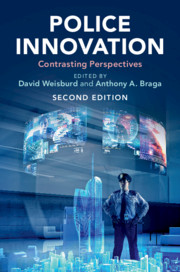Book contents
- Police Innovation
- Police Innovation
- Copyright page
- Contents
- Figures
- Tables
- Notes on Contributors
- Introduction
- Part I Community Policing
- Part II Procedural Justice Policing
- Part III Broken Windows Policing
- Part IV Problem–Oriented Policing
- Part V Pulling Levers (Focused Deterrence) Policing
- Part VI Third–Party Policing
- Part VII Hot Spots Policing
- Part VIII Predictive Policing
- Part IX CompStat
- 17 Advocate
- 18 Critic
- Part X Evidence-Based/ Risk-Focused Policing
- Part XI Technology Policing
- Index
- References
18 - Critic
Changing Everything so that Everything Can Remain the Same: CompStat and American Policing
from Part IX - CompStat
Published online by Cambridge University Press: 09 August 2019
- Police Innovation
- Police Innovation
- Copyright page
- Contents
- Figures
- Tables
- Notes on Contributors
- Introduction
- Part I Community Policing
- Part II Procedural Justice Policing
- Part III Broken Windows Policing
- Part IV Problem–Oriented Policing
- Part V Pulling Levers (Focused Deterrence) Policing
- Part VI Third–Party Policing
- Part VII Hot Spots Policing
- Part VIII Predictive Policing
- Part IX CompStat
- 17 Advocate
- 18 Critic
- Part X Evidence-Based/ Risk-Focused Policing
- Part XI Technology Policing
- Index
- References
Summary
CompStat emerged in the mid 1990s and quickly came to be seen as a major innovation in American policing. By the turn of the century it had received national awards from Harvard University and former Vice President Gore, and was featured prominently along with William Bratton (the police administrator who created the program) in the national news media. Its originators and proponents gave CompStat credit for impressive reductions in crime and improvements in neighborhood quality of life in a number of cities that had adopted the program (Silverman, 1996; Remnick, 1997; Gurwitt, 1998; Bratton, 1999). And while CompStat was first introduced only in 1994 in New York City, police departments around the country had begun to adopt it or variations of it by the first decade of the new century (Law Enforcement News, 1997; Maas, 1998; McDonald, 1998; Weisburd et al., 2003; Willis, Mastrofski & Kochel, 2010a). Indeed, in a Police Foundation survey conducted only six years after CompStat emerged on the scene in New York City, more than a third of American police agencies with 100 or more sworn officers claimed to have implemented a CompStat-like program (Weisburd et al., 2001). By 2006, Willis, Mastrofski, and Kochel (2010b) reported that about 60 percent of large police agencies had adopted CompStat, and a Police Executive Research Forum membership survey in 2011 reported that 85 percent of 166 responding member agencies reported having adopted or plans to adopt CompStat (Bureau of Justice Assistance & Police Executive Research Forum, 2013). Drawing on this survey and the comments of police leaders, researchers, and others attending a conference on CompStat in 2013, a report on the meeting offered a uniformly positive assessment of CompStat’s performance to date, as well as its future potential: “Regardless of how it develops in the future, it is clear that Compstat has become an integral part of policing in the United States by helping agencies become more productive, agile, and effective” (BJA & PERF, 2013: 30).
- Type
- Chapter
- Information
- Police InnovationContrasting Perspectives, pp. 417 - 436Publisher: Cambridge University PressPrint publication year: 2019
References
- 3
- Cited by



